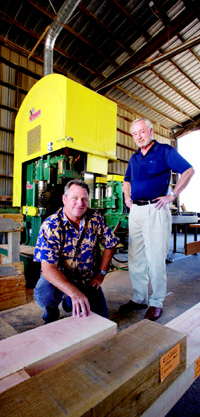But instead of queuing up to bid for the big production accounts with every other truss supplier, Barr went a different route, targeting the small custom home builders that had become dependent on the trussed-roof labor trend but were getting little attention from high-volume component shops. “The custom guys got kicked around when things got really busy,” Byers says. “All the big truss yards, all they wanted was the big multi-unit, multi-plan production work. So we figured we’d have [custom] guys calling and begging us to do their trusses.”
The prediction was extremely accurate. “Almost all of the truss yards down here are stand-alone rather than part of a lumberyard, that’s true,” says Randy Hess, president of San Bernardino–based Hess Contracting, a custom home builder cranking out approximately 25 homes a year and a devout Barr Lumber truss purchaser. “[But] there are still builders waiting months to get their trusses from other providers. I don’t buy from anywhere else.”
While Barr benefits from a higher margin on the more intricate custom truss jobs—prices approach $4 per square foot, compared to about $2.50 on the tract side—volume is significantly lower than local competitors, whose full-bore production truss plants in the area do about $4 million per month, according to Byers. “There are some fairly large truss builders in Southern California,” agrees Carroll. “Cal Truss and Reliable—they do a high volume production. We’re not a major operation in the sense of having six tables and eight saws.” Barr, however, benefits from a full-line lumberyard that can cater to the additional product needs of custom builders. Even lumber package sales have been catalyzed by a whole-house supply strategy that is a convenient upsell to the one-stop-shopping mentality of custom builder customers. “We get our full lumber package from Barr in addition to the roof trusses,” says Hess, who adds that personalized customer service in addition to one-stop availability of product keeps him buying from the pro dealer compared to higher volume, tract-focused suppliers. “I get [the opportunity] to know them on a personal level, they treat me as an individual rather than just a number, and the prices are good. I can work directly with management and get to establish business relationships with them.”
Leverage Your Resources Even as Barr settled into the increased popularity among truss-seeking custom accounts, however, component dollar volume struggled to get beyond $100,000 per month. By 2002, it had become evident that the truss manager, who had relocated from Yucca Valley, was uncomfortable with the pressure to increase productivity. He was more of what they call a “backyard truss builder,” Shirley says. “He was very comfortable with doing about $50,000 a month. We built a nice operation and picked it up to about $100,000, but that was all he could do for us.”
After an amicable parting of the ways with the manager, Byers and Shirley were faced with a huge management vacancy to fill even as they yearned to jump to the next level of production and profitability. “We hired a headhunter who brought in some candidates, but we felt that we had guys already on staff just as good in terms of sales and production experience,” Shirley explains. “Not only was it more cost effective for us to develop our in-house talent, but hopefully you develop some loyalty as well.”
Carroll and another designer emerged as suitable candidates to become truss sales managers, and received some classroom training in design, production, and sales to fortify their leap into management positions. “It was literally on-the-job training—we got thrown into the deep end,” says Carroll. “But there is a sense of loyalty there. I do think that you get a little more quality and a little more pride from people when they have been given opportunity.”
According to Byers, the decision to give employees the shot at management immediately and successfully played into growth plans for Barr’s truss operations. “Things just took off,” he says. “Our management was motivated, we hit an extremely good market, and we started turning trusses, really feeling the pressure, rolling one after another at over $100,000 per month.”
Slow but Steady Since 2002, Barr has steadily increased that productivity growth, which now pushes $250,000 in volume during a good month. In fact, the entire crew is poised to again “jump a level,” as Byers puts it, and plans are in the works to essentially double capacity with the addition of a second assembly table and components saw. To prepare for the incoming volume, Carroll and the designers have upgraded their office facilities from a single to a double-wide trailer and are preparing for changes in both the technology and procedures involved in designing Barr trusses.
“We are running Vector-Works [design software] now, but we’ll probably switch to AutoCAD in four months, which is typically No. 1 as far as architect usage in our market,” says Carroll. “The trend is also moving from hard copy plans to e-mailed plans. The engineers and architects here are pushing that. So we are preparing ourselves for the possibility in the future that hard copy may not be coming this way.”
In equipment terms, Byers sees no reason why Barr shouldn’t continue taking the old-school route, using wood tables versus gantry tables, and $70,000 motor-set saws versus $300,000 computer-set saws. “With components, you have to be a low-cost provider,” he advises. “In a business where you go from making 3 cents on the dollar in a good year to making 1 cent on the dollar in a bad year, you’d better not be too good looking or too high end.”

